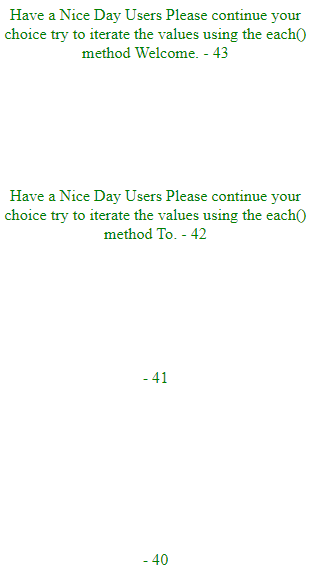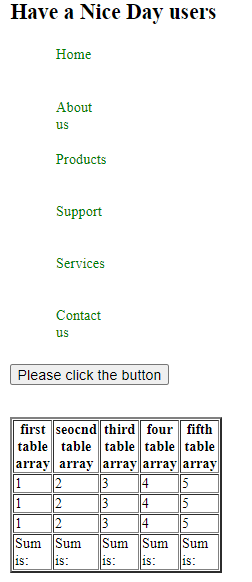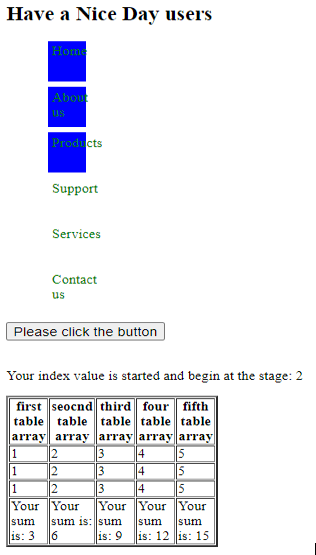Updated April 19, 2023

Introduction to jQuery array each
The jQuery array each is one of the functions that can be used to iterate the values it also creates the separate object associated with the collections. It can be of array or object in case of the array the callback is passing to the array index with the corresponding values. For each time the argument value is passed at the same position to the element, each() also it’s a generic iterator function it calculates the length of the index of the array-based object is started at the range from 0 to -1. we can also use callback function to execute each type of value.
Syntax:
In jQuery array each() is one of the methods in the jQuery collections and it is used to iterate over the matched elements in the collection. The index of the element will be passing to the current index which is pointed to the argument parameter to the callback methods.
<html>
<head>
<script src=" https://code.jquery.com/jquery-3.5.0.js"/>
</head>
<body>
<script>
var or let vars=["",""];
var or let vars1 = { };
jQuery.each(vars, function(variable, variable1) {
----some logics depends on the user requirement----
});
</script>
</body>
</html>The above codes are the basic syntax for utilizing jQuery.each() method in the web-based application.
How array each method works in jQuery?
JQuery has default methods for implementing the UI application with a user-friendly environment. Basically, each() method is used in the loop statement to iterate the values with each pair. Iterator may be of any type like objects or arrays both are calculating with the length property terms and each one has separate functional arguments. It also return the $.each() function internally in the method used to store and retrieve the data for length property with an array or object is passing to the script. It’s a conjunction with the jQuery object using the DOM elements also the array is iterated in the same way as we mentioned earlier in the array for the specific variable. So the wrapped elements are in the out-of-the-box behavior. We do not include index and value these are the just parameters or arguments related to the DOM element that will be currently iterated it. Sometimes the jQuery.each() method has some delay with the user elements also we can break the $.each() method in the sometimes on the loop iteration with particular time it makes the callback function with return value as boolean conditions like true or false. If the condition is true then it continues the same as the statement which has declared in the loop statements using continue keyword we can progress the statement it also skips the statement immediately to the next iteration.
Example #1
Code:
<!DOCTYPE html>
<html>
<head>
<style>
div { color:green;
width: 342px;
height: 177px;
padding-top: 25px;
padding-left: 6px;
font-size: 18px;
text-align: center;
}
New { color:red;
width: 342px;
height: 377px;
padding-top: 25px;
padding-left: 6px;
font-size: 18px;
text-align: center;
background-color: green;
}
</style>
<script src="http://code.jquery.com/jquery-latest.js"></script>
</head>
<body>
<div id="Welcome"></div>
<div id="To"></div>
<div id="My"></div>
<div id="Domain"></div>
<div id="New"></div>
<script>
var vars = [ "Welcome", "To", "My", "Domain", "New" ];
var vars1 = { Welcome:43, To:42, My:41, Domain:40, New:35 };
jQuery.each(vars, function() {
$("#" + this).text("Have a Nice Day Users Please continue your choice try to iterate the values using the each() method " + this + ".");
return (this != "To");
});
jQuery.each(vars1, function(i, val) {
$("#" + i).append(document.createTextNode(" - " + val));
});
</script>
</body>
</html>Output:
In the above example we used jQuery.each() method with the separate index of each element which is presented in the stack. That is vars declared on the variable either var or let keyword we can also append the text by using the append() method on the each() function.
Example #2
Code:
<!DOCTYPE html>
<html>
<head>
<title> Welcome To My Domain its a second example </title>
<script src="https://ajax.googleapis.com/ajax/libs/jquery/3.5.1/jquery.min.js"></script>
<style>
new{
text-align: center;
}
ul{
list-style-type: none;
float: center;
color:green;
}
li {
width: 34px;
height: 43px;
margin: 7px;
padding: 4px;
font-size: 16px;
float: center;
border: 3px blue;
color:green
}
button{
font-size: 16px;
}
</style>
</head>
<body>
<h2> Have a Nice Day users</h2>
<ul>
<li> Home </li>
<li> About us </li>
<li id = "first"> Products </li>
<li> Support </li>
<li> Services </li>
<li> Contact us </li>
</ul>
<button onclick = "demo()"> Please click the button </button> <br/><br/>
<p></p>
<script>
function demo() {
$(document).ready(function(){
$("li").each(function(index, valus) {
$(valus).css("background", "blue");
if ($(this).is("#first")) {
$("p").text("Your index value is started and begin at the stage: " + index ).css("fontSize", "16px");
return false;
}
});
});
$('table thead th').each(function(i) {
example(i);
});
}
function example(index) {
var tt = 0;
$('table tr').each(function() {
var vals = parseInt($('td', this).eq(index).text());
if (!isNaN(vals)) {
tt += vals;
}
});
$('table tfoot td').eq(index).text('Your sum is: ' + tt);
}
</script>
<table id="first" width="129" border="3">
<thead>
<tr>
<th>first table array</th>
<th>seocnd table array</th>
<th>third table array</th>
<th>four table array</th>
<th>fifth table array</th>
</tr>
</thead>
<tbody>
<tr>
<td>1</td>
<td>2</td>
<td>3</td>
<td>4</td>
<td>5</td>
</tr>
<tr>
<td>1</td>
<td>2</td>
<td>3</td>
<td>4</td>
<td>5</td>
</tr>
<tr>
<td>1</td>
<td>2</td>
<td>3</td>
<td>4</td>
<td>5</td>
</tr>
</tbody>
<tfoot>
<tr>
<td>Sum is:</td>
<td>Sum is:</td>
<td>Sum is:</td>
<td>Sum is:</td>
<td>Sum is:</td>
</tr>
</tfoot>
</table>
</body>
</html>Output:
After clicking on the button:
In the Second example, we developed some UI tag elements using the $.each() method when we click the button it starts to highlights the index of the elements upto the end index which is declared from the script. Also here we used table HTML elements for string and calculating the array elements in the table format.
Example #3
Code:
<!DOCTYPE html>
<html>
<head>
<title> Welcome To My Domain it’s a third example </title>
<script src="https://ajax.googleapis.com/ajax/libs/jquery/3.5.1/jquery.min.js"></script>
<style>
</style>
</head>
<body>
<h2> Have a Nice Day users</h2>
<script>
var vars = {
"a": "A",
"b": "B",
"c":"C",
"d":"D",
"e":"E"
};
$.each( vars, function( index, vals ) {
alert( index + ": " + vals );
});
</script>
</body>
</html>Output:
In the final example, we used a normal array with index-based elements is declared on the variable vars. By using the $.each() method we can pass the “index” and “vals” using the alert() function it alerts the results.
Conclusion
The jQuery.each() method is one of the valuable and precious methods by using the array concept in web application. By using this we can make and reduce the number of lines as much shorter and smarter when compared with other methods. It supports the array, collection, and util packages used on the javascript library.
Recommended Articles
This is a guide to jQuery array each. Here we discuss the description, syntax, How array each method works in jQuery and examples with code implementation. You may also have a look at the following articles to learn more –





